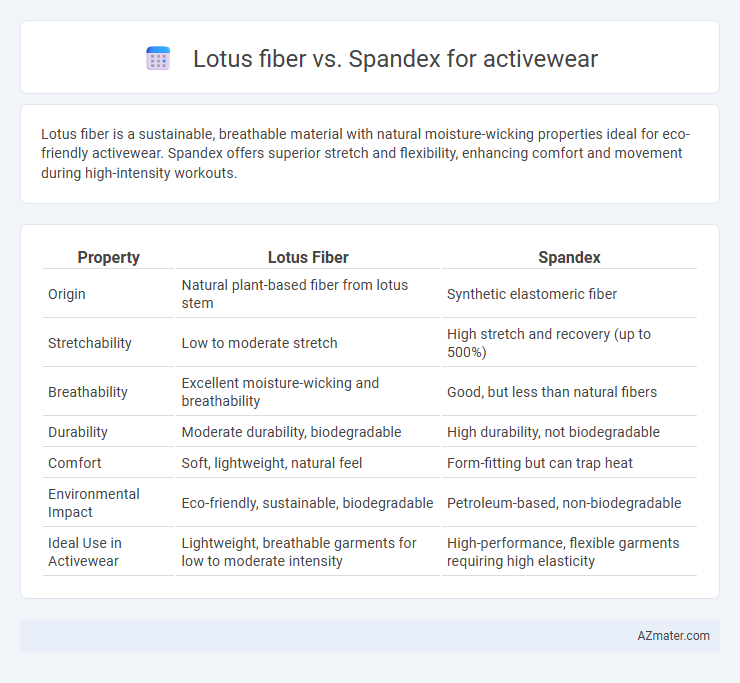Lotus fiber is a sustainable, breathable material with natural moisture-wicking properties ideal for eco-friendly activewear. Spandex offers superior stretch and flexibility, enhancing comfort and movement during high-intensity workouts.
Table of Comparison
| Property | Lotus Fiber | Spandex |
|---|---|---|
| Origin | Natural plant-based fiber from lotus stem | Synthetic elastomeric fiber |
| Stretchability | Low to moderate stretch | High stretch and recovery (up to 500%) |
| Breathability | Excellent moisture-wicking and breathability | Good, but less than natural fibers |
| Durability | Moderate durability, biodegradable | High durability, not biodegradable |
| Comfort | Soft, lightweight, natural feel | Form-fitting but can trap heat |
| Environmental Impact | Eco-friendly, sustainable, biodegradable | Petroleum-based, non-biodegradable |
| Ideal Use in Activewear | Lightweight, breathable garments for low to moderate intensity | High-performance, flexible garments requiring high elasticity |
Introduction to Lotus Fiber and Spandex
Lotus fiber, derived from the stems of lotus plants, is a sustainable and biodegradable material prized for its natural breathability, moisture-wicking properties, and soft texture, making it ideal for eco-friendly activewear. Spandex, a synthetic fiber known for its exceptional elasticity, provides superior stretch, shape retention, and durability, commonly used in performance-enhancing activewear for flexibility and comfort. Combining lotus fiber's eco-conscious benefits with spandex's stretch capabilities results in innovative, comfortable, and sustainable activewear options.
Origins and Production Methods
Lotus fiber is derived from the stems of lotus plants through an eco-friendly, labor-intensive process that involves hand extraction and drying, making it a rare and sustainable textile option. Spandex, a synthetic fiber invented in the 1950s, is produced through a chemical polymerization process using polyurethane, enabling high elasticity and durability. The natural origin and biodegradability of lotus fiber contrast sharply with the petroleum-based production and non-biodegradable nature of spandex, highlighting key differences in environmental impact and manufacturing complexity.
Sustainability and Environmental Impact
Lotus fiber, derived from the lotus plant's stems, offers a highly sustainable alternative to synthetic materials like spandex due to its biodegradable nature and minimal water usage during cultivation. Spandex, a petroleum-based fiber, presents environmental challenges including non-biodegradability and significant carbon emissions during production. Choosing lotus fiber for activewear reduces ecological footprints by promoting renewable resource use and lowering microplastic pollution in athletic apparel.
Comfort and Softness Comparison
Lotus fiber offers exceptional breathability and moisture-wicking properties, making it incredibly comfortable for activewear by keeping the skin cool and dry during intense workouts. It is naturally soft and hypoallergenic, providing a gentle touch ideal for sensitive skin compared to synthetic spandex, which can sometimes cause irritation due to less breathability. While spandex excels in stretch and flexibility, lotus fiber stands out in softness and comfort, enhancing overall wearability for prolonged physical activity.
Moisture-Wicking and Breathability
Lotus fiber offers superior breathability due to its naturally hollow fibers that enhance air circulation, making it highly effective for moisture-wicking in activewear. Spandex, while excellent for stretch and fit, lacks inherent moisture management properties, often requiring blending with other fibers for optimal sweat absorption and breathability. Athletes seeking natural, eco-friendly activewear benefit from lotus fiber's lightweight feel and moisture-wicking efficiency compared to synthetic spandex.
Durability and Stretchability
Lotus fiber offers moderate stretchability with excellent breathability, making it ideal for lightweight activewear but falls short in durability compared to synthetic fibers. Spandex provides superior stretchability and recovery, ensuring garments maintain shape during intense physical activities, while its durability withstands repeated wear and washing. Combining lotus fiber with spandex blends natural comfort with enhanced elasticity and long-lasting performance in activewear.
Performance in Activewear Applications
Lotus fiber offers excellent breathability and moisture-wicking properties, making it ideal for activewear that requires natural cooling and odor resistance during intense workouts. Spandex provides superior stretch and recovery, ensuring garments maintain shape and enhance flexibility for dynamic movements in high-performance activities. Combining lotus fiber with spandex blends can optimize activewear performance by balancing natural comfort with elasticity and durability.
Skin Sensitivity and Hypoallergenic Properties
Lotus fiber offers exceptional hypoallergenic properties, making it ideal for sensitive skin due to its natural antimicrobial and moisture-wicking capabilities. Spandex, while providing superior stretch and flexibility, may cause irritation in individuals with skin sensitivities as it is typically blended with synthetic materials that trap heat and moisture. Choosing activewear made from lotus fiber enhances comfort for people prone to allergies and skin irritation, promoting breathability and reducing the risk of dermatitis.
Style, Colors, and Fabric Aesthetics
Lotus fiber offers a unique, natural texture with a soft sheen that enhances the style and elegance of activewear, while spandex provides a smooth, sleek appearance ideal for fitted, performance-driven designs. Lotus fiber typically comes in earthy, muted tones that emphasize eco-friendly aesthetics, contrasting with the vibrant, bold color range achievable through synthetic spandex dyeing processes. The breathable, matte finish of lotus fiber appeals to consumers seeking sustainable fashion, whereas spandex's glossy stretch fabric caters to those prioritizing flexibility and dynamic movement in athletic wear.
Price, Availability, and Market Trends
Lotus fiber, derived from sustainable plant sources, is priced higher than Spandex due to its eco-friendly production and limited availability in niche markets. Spandex dominates the activewear industry with its affordability, wide availability, and superior stretch properties, driving strong market demand. Emerging trends show a gradual rise in consumer interest towards Lotus fiber as brands seek sustainable alternatives, yet Spandex remains the preferred choice for mainstream activewear manufacturing.

Infographic: Lotus fiber vs Spandex for Activewear
 azmater.com
azmater.com